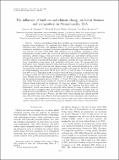| dc.contributor.author | Thompson, Jonathan R. | |
| dc.contributor.author | Foster, David Russell | |
| dc.contributor.author | Scheller, Robert M | |
| dc.contributor.author | Kittredge, David B. | |
| dc.date.accessioned | 2017-03-08T16:28:51Z | |
| dc.date.issued | 2011 | |
| dc.identifier.citation | Thompson, Jonathan R., David R. Foster, Robert Scheller, and David Kittredge. 2011. The Influence of Land Use and Climate Change on Forest Biomass and Composition in Massachusetts, USA. Ecological Applications 21, no. 7: 2425–2444. doi:10.1890/10-2383.1. | en_US |
| dc.identifier.issn | 1051-0761 | en_US |
| dc.identifier.uri | http://nrs.harvard.edu/urn-3:HUL.InstRepos:30653604 | |
| dc.description.abstract | Land use and climate change have complex and interacting effects on naturally dynamic forest landscapes. To anticipate and adapt to these changes, it is necessary to understand their individual and aggregate impacts on forest growth and composition. We conducted a simulation experiment to evaluate regional forest change in Massachusetts, USA over the next 50 years (2010–2060). Our objective was to estimate, assuming a linear continuation of recent trends, the relative and interactive influence of continued growth and succession, climate change, forest conversion to developed uses, and timber harvest on live aboveground biomass (AGB) and tree species composition. We examined 20 years of land use records in relation to social and biophysical explanatory variables and used regression trees to create ‘‘probability-of-conversion’’ and ‘‘probability-of-harvest’’ zones. We incorporated this information into a spatially interactive forest landscape simulator to examine forest dynamics as they were affected by land use and climate change. We conducted simulations in a fullfactorial design and found that continued forest growth and succession had the largest effect on AGB, increasing stores from 181.83 Tg to 309.56 Tg over 50 years. The increase varied from 49% to 112% depending on the ecoregion within the state. Compared to simulations with no climate or land use, forest conversion reduced gains in AGB by 23.18 Tg (or 18%) over 50 years. Timber harvests reduced gains in AGB by 5.23 Tg (4%). Climate change (temperature and precipitation) increased gains in AGB by 17.3 Tg (13.5%). Pinus strobus and Acer rubrum were ranked first and second, respectively, in terms of total AGB throughout all simulations. Climate change reinforced the dominance of those two species. Timber harvest reduced Quercus rubra from 10.8% to 9.4% of total AGB, but otherwise had little effect on composition. Forest conversion was generally indiscriminate in terms of species removal. Under the naı¨ve assumption that future land use patterns will resemble the recent past, we conclude that continued forest growth and recovery will be the dominant mechanism driving forest dynamics over the next 50 years, and that while climate change may enhance growth rates, this will be more than offset by land use, primarily forest conversion to developed uses. | en_US |
| dc.description.sponsorship | Organismic and Evolutionary Biology | en_US |
| dc.language.iso | en_US | en_US |
| dc.publisher | Wiley-Blackwell | en_US |
| dc.relation.isversionof | doi:10.1890/10-2383.1 | en_US |
| dash.license | LAA | |
| dc.subject | aboveground biomass | en_US |
| dc.subject | climate change | en_US |
| dc.subject | current trends | en_US |
| dc.subject | forest carbon sequestration | en_US |
| dc.subject | future scenarios | en_US |
| dc.subject | Massachusetts, USA | en_US |
| dc.subject | landscape simulation | en_US |
| dc.subject | land use legacies | en_US |
| dc.subject | old-growth forest | en_US |
| dc.title | The influence of land use and climate change on forest biomass and composition in Massachusetts, USA | en_US |
| dc.type | Journal Article | en_US |
| dc.description.version | Version of Record | en_US |
| dc.relation.journal | Ecological Applications | en_US |
| dash.depositing.author | Foster, David Russell | |
| dc.date.available | 2017-03-08T16:28:51Z | |
| dc.identifier.doi | 10.1890/10-2383.1 | * |
| dash.contributor.affiliated | Thompson, Jonathan | |
| dash.contributor.affiliated | Kittredge, David | |
| dash.contributor.affiliated | Scheller, Robert | |
| dash.contributor.affiliated | Foster, David | |


